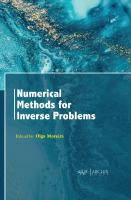Advances in Numerical Methods for Hyperbolic Balance Laws and Related Problems 9783031298745, 9783031298752
123 6 5MB
English Pages 242 Year 2023
Table of contents :
Preface
Contents
Contributors
A Tree Structure Approach to Reachability Analysis
1 Introduction
2 Problem Setup
3 Backwards Reachability
4 Forwards Reachability
5 A Tree-Based Algorithm for Computing Reachable Sets
6 Numerical Examples
6.1 Numerical Example 1: Linear System with Two States
6.2 Numerical Example 2: DC Motor
7 Conclusions and Future Works
References
Asymptotic-Preserving Neural Networks for Hyperbolic Systems with Diffusive Scaling
1 Introduction
2 Hyperbolic Systems with Diffusive Scaling
3 Review of Deep Neural Networks and Physics-Informed Neural Networks
3.1 Deep Neural Networks (DNNs)
3.2 Physics-Informed Neural Networks (PINNs)
4 Asymptotic-Preserving Neural Networks
4.1 APNN for the Goldstein-Taylor Model
5 Application to the Goldstein-Taylor Model
5.1 Standard DNN Versus Standard PINN in Hyperbolic Regime
5.2 Standard PINN Versus APNN in Diffusive Regime
6 Application to Epidemic Dynamics
6.1 The Multiscale Hyperbolic SIR Model
6.2 APNN for the Hyperbolic SIR Model
6.3 APNN Performance with Epidemic Dynamics
7 Conclusion
References
A Non-local System Modeling Bi-directional Traffic Flows
1 Introduction
2 A Non-local Bi-directional Traffic Flow Model
3 Existence of Weak Solutions
4 Numerical Tests
4.1 Kernel Support Tending to Zero
4.2 Asymptotic Behaviour in a Periodic Setting
4.3 Maximum Principle
References
Semi-implicit Finite-Difference Methods for Compressible Gas Dynamics with Curved Boundaries: A Ghost-Point Approach
1 Introduction
2 Finite-Difference Methods for Conservation Laws
2.1 Compressible Euler Equations of Gas Dynamics
2.2 Explicit and Semi-implicit Spatial Discretization
2.3 Explicit and Semi-implicit Time Discretization
2.4 Discretization of Compressible Euler Equations in 2D
3 Ghost-Point Method for Boundary Conditions
3.1 Ghost-Point Technique for Implicit Solvers
4 Numerical Simulations
4.1 Square Obstacle
4.2 Circular Obstacle
4.3 Shock Tube Problems
5 Conclusions
References
High-Order Arbitrary-Lagrangian-Eulerian Schemes on Crazy Moving Voronoi Meshes
1 Introduction
1.1 Goals
1.2 Structure
2 Hyperbolic Partial Differential Equations
3 Numerical Method
3.1 Direct Arbitrary-Lagrangian-Eulerian Schemes
3.2 Topology Changes and Crazy Sliver Elements
3.3 ADER-ALE Algorithm: The Predictor Step
3.4 A Posteriori Sub-cell FV Limiter
4 Numerical Examples
4.1 Long Time Evolution of a Shu-type Vortical Equilibrium
4.2 Sedov Explosion Problem
4.3 Traveling Sod-type Explosion Problem
5 Conclusion and Outlook
References
Overview on Uncertainty Quantification in Traffic Models via Intrusive Method
1 Introduction
2 Stochastic Galerkin Approach
3 Microscopic Scale
4 Mesoscopic Scale
5 Macroscopic Scale
5.1 From Micro to Macro
5.2 From Meso to Macro
5.3 Numerical Test
6 Conclusion and Future Perspectives
References
A Study of Multiscale Kinetic Models with Uncertainties
1 Introduction
2 Mathematical Theory for Uncertain Kinetic Equations
2.1 Theoretical Framework: The Perturbative Setting
2.2 Convergence to the Global Equilibrium
3 Stochastic Galerkin Method: An Intrusive Scheme
3.1 Error Analysis of the gPC-SG System
3.2 Stochastic AP Schemes
4 Multi-fidelity Method: A Non-intrusive Scheme
4.1 A Bi-fidelity Stochastic Collocation (BFSC) Algorithm
4.2 Numerical Examples
5 Conclusion
References
On the Shock Wave Discontinuities in Grad Hierarchy for a Binary Mixture of Inert Gases
1 Introduction
2 13–Moment Equations and Principal Subsystems
3 The Shock Wave Problem
3.1 Singularity Manifolds and Critical Mach Numbers
4 Singularity Analysis
References
A Conservative a-Posteriori Time-Limiting Procedure in Quinpi Schemes
1 Introduction
2 Quinpi Scheme for Hyperbolic Conservation Laws
2.1 The Quinpi Approach
3 Numerical Tests
3.1 Test 1: Experimental Order of Convergence
3.2 Test 2: Linear Transport Problem
3.3 Test 3: Burgers Equation
3.4 Computational Performance of the Quinpi Schemes
4 Conclusion and Perspectives
References
Applications of Fokker Planck Equations in Machine Learning Algorithms
1 Introduction
2 Algorithmic Fairness for Imbalanced Data
2.1 Setting
2.2 Theorems
3 Asynchronous Stochastic Gradient Descent
3.1 Setting
3.2 Theorems
4 Reinforcement Learning in Smooth Environment
4.1 Setting
4.2 Theorems
5 Conclusion
References
Preface
Contents
Contributors
A Tree Structure Approach to Reachability Analysis
1 Introduction
2 Problem Setup
3 Backwards Reachability
4 Forwards Reachability
5 A Tree-Based Algorithm for Computing Reachable Sets
6 Numerical Examples
6.1 Numerical Example 1: Linear System with Two States
6.2 Numerical Example 2: DC Motor
7 Conclusions and Future Works
References
Asymptotic-Preserving Neural Networks for Hyperbolic Systems with Diffusive Scaling
1 Introduction
2 Hyperbolic Systems with Diffusive Scaling
3 Review of Deep Neural Networks and Physics-Informed Neural Networks
3.1 Deep Neural Networks (DNNs)
3.2 Physics-Informed Neural Networks (PINNs)
4 Asymptotic-Preserving Neural Networks
4.1 APNN for the Goldstein-Taylor Model
5 Application to the Goldstein-Taylor Model
5.1 Standard DNN Versus Standard PINN in Hyperbolic Regime
5.2 Standard PINN Versus APNN in Diffusive Regime
6 Application to Epidemic Dynamics
6.1 The Multiscale Hyperbolic SIR Model
6.2 APNN for the Hyperbolic SIR Model
6.3 APNN Performance with Epidemic Dynamics
7 Conclusion
References
A Non-local System Modeling Bi-directional Traffic Flows
1 Introduction
2 A Non-local Bi-directional Traffic Flow Model
3 Existence of Weak Solutions
4 Numerical Tests
4.1 Kernel Support Tending to Zero
4.2 Asymptotic Behaviour in a Periodic Setting
4.3 Maximum Principle
References
Semi-implicit Finite-Difference Methods for Compressible Gas Dynamics with Curved Boundaries: A Ghost-Point Approach
1 Introduction
2 Finite-Difference Methods for Conservation Laws
2.1 Compressible Euler Equations of Gas Dynamics
2.2 Explicit and Semi-implicit Spatial Discretization
2.3 Explicit and Semi-implicit Time Discretization
2.4 Discretization of Compressible Euler Equations in 2D
3 Ghost-Point Method for Boundary Conditions
3.1 Ghost-Point Technique for Implicit Solvers
4 Numerical Simulations
4.1 Square Obstacle
4.2 Circular Obstacle
4.3 Shock Tube Problems
5 Conclusions
References
High-Order Arbitrary-Lagrangian-Eulerian Schemes on Crazy Moving Voronoi Meshes
1 Introduction
1.1 Goals
1.2 Structure
2 Hyperbolic Partial Differential Equations
3 Numerical Method
3.1 Direct Arbitrary-Lagrangian-Eulerian Schemes
3.2 Topology Changes and Crazy Sliver Elements
3.3 ADER-ALE Algorithm: The Predictor Step
3.4 A Posteriori Sub-cell FV Limiter
4 Numerical Examples
4.1 Long Time Evolution of a Shu-type Vortical Equilibrium
4.2 Sedov Explosion Problem
4.3 Traveling Sod-type Explosion Problem
5 Conclusion and Outlook
References
Overview on Uncertainty Quantification in Traffic Models via Intrusive Method
1 Introduction
2 Stochastic Galerkin Approach
3 Microscopic Scale
4 Mesoscopic Scale
5 Macroscopic Scale
5.1 From Micro to Macro
5.2 From Meso to Macro
5.3 Numerical Test
6 Conclusion and Future Perspectives
References
A Study of Multiscale Kinetic Models with Uncertainties
1 Introduction
2 Mathematical Theory for Uncertain Kinetic Equations
2.1 Theoretical Framework: The Perturbative Setting
2.2 Convergence to the Global Equilibrium
3 Stochastic Galerkin Method: An Intrusive Scheme
3.1 Error Analysis of the gPC-SG System
3.2 Stochastic AP Schemes
4 Multi-fidelity Method: A Non-intrusive Scheme
4.1 A Bi-fidelity Stochastic Collocation (BFSC) Algorithm
4.2 Numerical Examples
5 Conclusion
References
On the Shock Wave Discontinuities in Grad Hierarchy for a Binary Mixture of Inert Gases
1 Introduction
2 13–Moment Equations and Principal Subsystems
3 The Shock Wave Problem
3.1 Singularity Manifolds and Critical Mach Numbers
4 Singularity Analysis
References
A Conservative a-Posteriori Time-Limiting Procedure in Quinpi Schemes
1 Introduction
2 Quinpi Scheme for Hyperbolic Conservation Laws
2.1 The Quinpi Approach
3 Numerical Tests
3.1 Test 1: Experimental Order of Convergence
3.2 Test 2: Linear Transport Problem
3.3 Test 3: Burgers Equation
3.4 Computational Performance of the Quinpi Schemes
4 Conclusion and Perspectives
References
Applications of Fokker Planck Equations in Machine Learning Algorithms
1 Introduction
2 Algorithmic Fairness for Imbalanced Data
2.1 Setting
2.2 Theorems
3 Asynchronous Stochastic Gradient Descent
3.1 Setting
3.2 Theorems
4 Reinforcement Learning in Smooth Environment
4.1 Setting
4.2 Theorems
5 Conclusion
References

- Author / Uploaded
- Giacomo Albi
- Walter Boscheri
- Mattia Zanella









